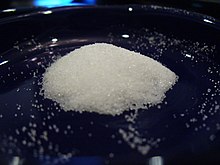Iodized salt
Iodized salt (also: iodized salt ) is a table salt that is enriched with iodate . It is offered for the prevention ( iodine prophylaxis ) or treatment of iodine deficiency .
commitment
Iodized salt contains around 15 to 25 mg of iodine (as iodate) per kilogram of salt. Iodination of the table salt sold is or was mandatory in Switzerland , Austria , the USA and until reunification in the GDR . In the unified Germany, the use of iodized salt is not required by law, but it is now used by the majority of households and restaurants. In the meantime, according to the WHO criteria, Germany is no longer regarded as an iodine undersupply or iodine deficiency area, which is largely due to the increased consumption of iodized table salt. Practically all major health organizations such as the United Nations , UNICEF , WHO , Iodine Global Network (formerly ICCIDD Global Network) and specialist societies (ATA, ETA , Thyroid Section of the German Society for Endocrinology , German Society for Nutrition (DGE), Federal Center for Health Education ( BZgA)) therefore recommend the consumption of iodized salt for prophylaxis of iodine deficiency.
Background and medical history
The WHO estimates that around 750 million to 1 billion people worldwide are affected by iodine deficiency. In Western and Central Europe, this affects more than 380 million people. The main causes of iodine deficiency are on the one hand iodine-poor soils, which in turn produce low-iodine agricultural products, and on the other hand, low consumption of sea fish, since fish from inland waters (lakes and rivers) contain only little iodine. Accordingly, the iodine deficiency mainly affects areas far from the coast. In Europe, these were traditionally the Alpine countries and the Balkans. In North America it was especially the areas around the great lakes .
From 1918 onwards, the Swiss doctor Otto Bayard introduced iodized salt into the communities in his practice area in the Nikolaital, using the right amount of iodine in the table salt, and showed that development disorders, the enlargement of the thyroid gland, goiter and nodule formation were not undesirable and have damage treated successfully. Building on this, the Swiss Goiter Commission, founded by the Federal Office of Public Health in 1922, recommended the use of iodized salt to the population and the twenty-five cantonal authorities, determining the amount of calcium iodine added to table salt on the basis of these empirical studies. The introduction of structured iodine prophylaxis according to Bayard throughout Switzerland in the following years had a worldwide pioneering character. In Austria, a ministerial recommendation was issued for the first time in 1923 to iodize full salt, but table salt iodination was not regulated by law until 1963. In an amendment to the Salt Act in 1990, the mandatory iodination was increased from 10 mg to 20 mg potassium iodide per kg salt. An amendment to the law in 1999 stipulated that table salt must contain at least 15 and at most 20 mg of potassium iodide or iodate per kg of salt.
Daily intake of iodine recommended by the DGE
The German Nutrition Society recommends the intake of 180–200 µg iodine / day for adults (slightly more for pregnant and breastfeeding women) and 40–200 µg for children and adolescents. The actual iodine intake in Germany in 2003 was estimated at 110–120 µg iodine / day in adults.
Iodized salt in stores
Conventional products are, for example, table salt fortified with iodine . Ready-made meals can also contain iodized salt. A note “with iodized table salt” or “with iodized salt” must appear on the packaging. The addition of iodine in animal feed increases the iodine content of meat, eggs and dairy products without this having to be stated. Its use in baked goods and sausages without a declaration is also widespread.
Fluoridated salt
In Germany and Switzerland, salt is also offered with the addition of fluoride . With regular use, fluoridated salt is said to be able to reduce tooth decay - controlled studies on this are only available for fluoride tablets.
See also
Web links
Individual evidence
- ↑ Ordinance amending the regulations on iodized table salt (Federal Law Gazette I, p. 1123 ff, 1989), BfR: Benefits and risks of iodine prophylaxis in Germany (PDF; 146 kB).
- ↑ a b Iodine status worldwide: WHO Global Database on Iodine Deficiency. Bruno de Benoist et al. (eds.): Department of Nutrition for Health and Development, World Health Organization, Geneva, 2004, ISBN 92-4-159200-1 ( pdf ).
- ^ Iodine Global Network .
- ^ American Thyroid Association .
- ^ European Thyroid Association .
- ↑ a b c DGE -Info: With iodized salt and a balanced diet consistently, effectively and safely against iodine deficiency. In: Research, Clinic and Practice 11/2003.
- ↑ https://www.schilddruesengesellschaft.at/sites/osdg.at/files/upload/MTA_16_S08.pdf
- ↑ http://heidelinde-lindorfer.com/jodseiten/grundlegende/salzjod.html
- ↑ https://www.ris.bka.gv.at/GeltendeFnahm.wxe?Abfrage=Bundesnormen&Gesetzesnummer=10010311
